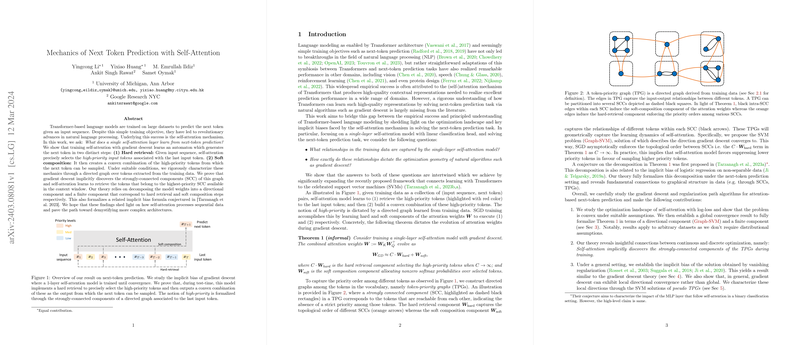Mechanics of Next Token Prediction with Self-Attention
The paper, "Mechanics of Next Token Prediction with Self-Attention," investigates the inner workings of a single-layer self-attention model when tasked with next-token prediction using gradient descent optimization. The analysis elucidates how this fundamental building block of Transformer-based LLMs acquires the ability to generate the next token effectively.
Core Findings
The authors introduce a dual-phase mechanism inherent in self-attention training:
- Hard Retrieval: This involves the precise selection of high-priority tokens related to the last input token.
- Soft Composition: This phase constructs a convex combination of the retrieved tokens to sample the next token.
The researchers introduce and formalize the concept of strongly connected components (SCCs) within directed token-priority graphs (TPGs). TPGs encapsulate the relationships within training data. The gradient descent process implicitly identifies SCCs, thereby guiding self-attention to prioritize tokens from the highest-priority SCC within the context window.
Mathematical Formulation
The problem formulation hinges on analyzing a single-layer self-attention model trained with gradient descent for next-token prediction. Here are the salient steps:
- Input Representation: The input sequence and the corresponding token embeddings are represented in matrix form.
- Empirical Risk Minimization (ERM): The optimization problem aims to minimize the loss defined as the negative log-likelihood of correctly predicting the next token.
The solution to the problem is framed as finding weights such that:
- Token correlations adhere to the constraints imposed by TPGs:
- Enhancing priority correlation for .
- Neutralizing the correlation for .
The researchers derive the weight update mechanisms and utilize the convergence properties of gradient descent in this setting.
Key Results
- Global Convergence: For log-loss and under certain assumptions, they prove that gradient descent converges globally. This entails the attention weights evolving directionally towards the SVM solution.
- Feasibility of SVM: They establish that, provided the embedding matrix is full rank, the SVM problem associated with the token-priority graphs is feasible. This is significant because it ensures practical applicability in a wide range of scenarios where the vocabulary size does not exceed the embedding dimension.
The theoretical results are validated with experimental findings, showing that the gradient descent process indeed leads the attention weights to align with the SVM formulation, even for larger vocabulary scenarios where .
Implications and Future Work
This paper sheds light on the implicit biases of the self-attention mechanism in Transformer-based models, particularly in the context of next-token prediction. The authors' insights into the SCC-based token-priority mechanism pave the way for more precise characterization and potentially even the design of more efficient attention mechanisms.
Future research can expand on several fronts:
- Multi-layer and Multi-head Extensions: Extending the analysis to multi-layer, multi-head architectures typical of full-fledged Transformers.
- Impact of MLP Layers: Investigating how the feed-forward layers following self-attention in Transformers contribute to the observed token selection and composition mechanisms.
- Relaxation of Assumptions: Analyzing more complex settings without the convexity assumptions to generalize the convergence results further.
By distilling the mechanics of next-token prediction at the level of a single-layer self-attention model, this paper lays a robust theoretical foundation from which to explore and optimize more complex architectures in natural language processing and beyond.
